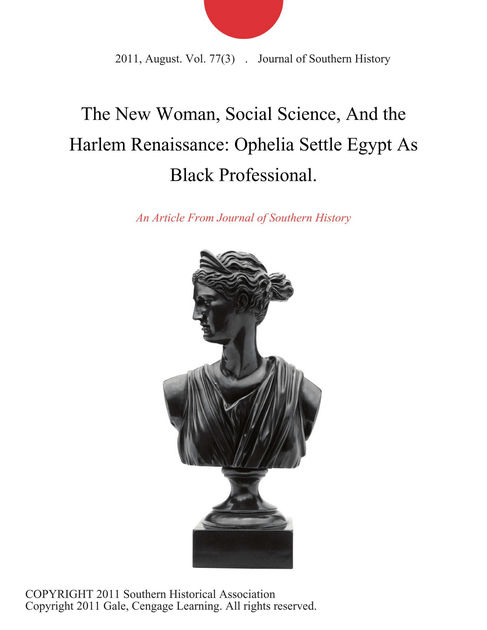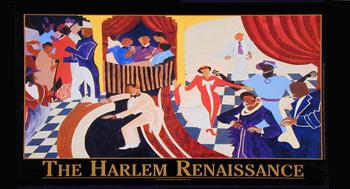

Today’s post are excerpts from The New Woman, Social Science, and the Harlem Renaissance: Ophelia Settle Egypt as Black Professional by Louise L. Stevenson

On Ophelia’s childhood, growing up with her grandparents who were former slaves:
As a very young child, Ophelia Settles enjoyed a childhood that encouraged literacy. Her father, a teacher, and his wife instilled in her a passion for reading and made her aware of the continuity from the written text to memorization and finally, to oral presentation. Born in northeast Texas near Clarksville, Ophelia would spent the rest of her childhood on her grandparents two-hundred acre farm near Garland, about thirty miles southwest of Clarksville, near Dallas. Her father sent his children there for his wife’s parents to raise after Opehlia’s mother (his second wife) died when she was 5 years old.
Moving to her grandparents home meant that the young Egypt no longer benefited from a household where everyone was literate. Her grandparents had been raised in slavery and only her grandfather had acquired elementary literacy. Nonetheless, the grandmother taughter her granddaughters unconventional lessons. A passage in Egypt’s memoir describes a thunderstorm that interrupted a reading of the Bible. Frequently, her older half sister Sudie, their grandmother and she gatered after cleaning up the dinner dishes to read by the light of a turpentine lamp One night, a thunderstorm appeared in the distance across the plains. As the storm winds swept closer, Sudie paused in her reading and blew out the flame. In the dark with the storm approaching, one voice continued and filled the void created by the young reader’s silence. Through the drumming of the rain and the whoosh of the wind, the voice of the grandmother recited the words of the 23rd psalm from a memory stoked by the repetition of church and at home readings: “While the lightening lashed and the thunder rocked the house, Grandma’s voice rang out loud and clear and beautiful: “though I walks through the shadow of the valley of death, I know no evil. For Thou art with me”.

Learning about human reproduction and lessons on womanhood from her grandmother:
In a memoir of her childhood, she tells of her ignorance of human reproduction. Despite growing up on a farm with its cycles of animal reproduction, she thought human babies arrived in a doctor’s black bag. Immediately before a baby was born in her community, the doctor arrived from the nearest town carrying a medical bag and riding a white horse. To confirm her theory about the bag’s contents, she and a friend investigated during the delivery of an aunt’s baby. The doctor arrived with his bag, the children had been banned to the neighbors and the female relatives had assembled in the ground floor bedroom the cellarless farmhouse. Defying their banishment, she and her friend wriggled under the house through the 18-inch crawl space beneath the floor until they were under the bedroom where the delivery was occurring. Their efforts brought no reward; the noises of the delivery did not answer their questions.
Some months previously, her grandmother had made necessary such subterfuge. She had slapped Ophelia who had asked why her pregnant aunt was getting fat. Neither did her grandmother prepare her for the onset of menstruation. When the flow began, Grandma told her merely how to tear and fold strips from old sheets and then to change the bandages before the blood seeped through. When she asked if a girl “could get a baby” before she married, Grandma responded “No! Nice girls don’t ever gt babies until after they are married. Don’t you ever let me hear you even thinking about such things. Nothing like that’s ever happened in our family and I pray to God it never will. Just keep your dress down and don’t fool with boys and you’ll be all right.” Unfortunately for her granddaughter, the warning did not bring enlightenment. Ophelia had no idea what fooling with boys might involve. She worried when they touched her or when the wind blew her skirt up.
From rural Texas to the pinnacle of African American intellectual society:
From girlhood in rural Texas, Egypt made her way to Howard University (1921-1925), earned a master’s degree in sociology at the University of Pennsylvania (1926-1928), and became a protégé of Charles S. Johnson, the eminent sociologist, and adviser to New Deal agencies, and the first black president of Fisk University (1946-1956). Thus, two generations after the end of slavery, Egypt moved from a family life with illiterate grandparents to membership in an educated elite. With her degrees, she reached an educational level occupied by less than 1 percent of the American population in the 1920s-man or woman, African American or white. She had left a rural culture with oral modes of communication and begun to study oral culture as a credentialed social scientist and member of the 20th century university world.
By 1929, Egypt was a professional social scientist collecting oral histories from her grandparents generation of ex-slaves. The education that qualified her to collect these oral histories had taken her to the centers of African American intellectual life in the twenties and thirties, including Howard and Fisk Universities as well as the cities of Philadelphia and New York City. In these centers, she met the leading figures of the Harlem Renaissance: sociologist Johnson, writer Zora Neal Hurston, philosopher Alain Locke, poet and dramatist Langston Hughes, poet James Weldon Johnson and impressionist artist Allan R. Freelon.
On Colorism and a grandmother’s lesson
Though college attendance for African Americans rose rapidly through the twenties, no unmarried, college-educated African American man was sufficiently attracted to her brains, her willfulness, and her dark skin to propose marriage. Colorism was prevalent on the Howard and Fisk campuses, which did not escape Ophelia. Photographs of the youthful Ophelia show her square face and heavy eyelids. She said that she was sensitive about them and her grandfather called her “Froggy.” As a child, she wanted straight hair like that of her grandmother, who taught the self-conscious youngster, “Pretty is as pretty does child. You’re pretty because you act pretty. Just always act pretty and everybody will KNOW you are pretty!”

On becoming a “modern woman” during the Harlem Renaissance
Membership in the Harlem Renaissance entailed more than intellectual engagement. Full membership involved one’s public and private life, thus encompassing Ophelia’s break from the sexual mores of her parents and grandparents. Whereas discussion of her reading appeared in letters to her friends, her closest friends alone knew the full extent to which she had become a modern woman.
Men noticed something other than her eyes and plain face. She intrigued them with her vivacious and ambitious nature. No matter where she lived, she had plenty of male partners.
She enjoyed affairs with single and married professionals – college educated dentists and doctors and small businessmen such as salesmen and barbers, and also, both African American and white. To maintain the appearance of conformity to conventional mores, she kept her adventures from professional colleagues to presumably because she realized as she told her close friend Glenn Carrington, she needed to defend herself “against promiscuity.” The adventuresome Ophelia confided in Carrington that she had as sexual partners two male “pals”, two lovers and an almost divorced doctor. Of these men, only the doctor fully satisfied her and caused her to worry that she was “oversexed.”
Such an adventuresome life probably did not violate the mores of Ophelia’s New York City friends to whom she confided. The Harlem Renaissance progressive crowd accepted racially mixed dating as well as gender mixed dating. Their city was the African American capital in the late 20s and 30s, home both to the intellectual life and to its eclectic social scene, including straight, homosexual and lesbian nightclubs. Indeed, Ophelia’s closest friend, Carrington, was a proud and open gay man. Many young Americans were casting aside patterns of Victorian socializing and marriage behavior that called for self-restraint and limited sexual intercourse. With the availability of the diaphragm and knowledge about contraception, sexual expression that did not regularly result in conception became possible. In her public and professional life, no one would know that Ophelia had violated her grandmother’s directive to keep her skirt down.
